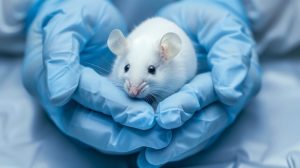
Inflammation of the abdominal cavity in human fetuses caused by perforation of the intestine is probably triggered by proteins in the fetus’ stool. This is the result of a study by Kobe University, which has created a new mouse model that enables the research and development of drugs for a disease that is otherwise difficult to access.
Life-Threatening Meconium Peritonitis
Although the fetal stool, known as “meconium”, is sterile, it causes inflammation of the abdominal cavity when it emerges from the intestine after a perforation. This disease, known as “meconium peritonitis”, is life-threatening for the child and has a mortality rate of 10 to 15% in humans, and there is neither a cause nor a treatment.

Pediatrician FUJIOKA Kazumichi from Kobe University and his team therefore decided to mimic the disease in mice. Since the intestinal development of mice and humans is different, the intestine of a newborn mouse pup corresponds to that of a human fetus after the twelfth week of pregnancy. The research team therefore prepared a mash from meconium taken from human newborns and injected it into the abdominal cavity of the pups. They then characterized the resulting condition and compared the mortality rate of the mice in response to the different treatments.
Their results, published in the journal Pediatric Research, show that mortality was not affected by antibiotic treatment, ruling out a bacterial cause. However, when the meconium slurry was heat-treated prior to injection, disrupting the natural form of the proteins, a significant reduction in mortality was observed. This suggests that proteins contained in the meconium are responsible for the inflammation, and the researchers suspect digestive enzymes in particular, which are abundant in meconium, as the culprit.
The Kobe University development also has broader implications. In another series of experiments, Fujioka and his team characterized the condition of mouse pups after administration of meconium mash by analyzing the biochemical and gene expression profiles of the mice. Compared to the results of a previously established mouse model in which the pups were injected with an extract of the intestinal contents of adult mice, they were able to show that their model leads to different symptoms. The researchers believe it is likely that their model is specific to meconium-induced inflammation and argue that it provides a suitable platform for further research into the disease.
Fujioka and his team hope that their work will facilitate the search for an effective treatment for the condition, which occurs in about one in 35,000 live births. They conclude their work by saying: “Since our mouse model is simple and highly reproducible, it can be used in research to elucidate the pathophysiology of meconium peritonitis.”


